Goodison Artifacts in the Museum Collection
Wooden Threshing Machine
This wooden threshing machine was made by the Goodison Company. Threshing machines or threshers are a huge piece of farm equipment that process wheat by removing the seeds from the stalks and husks. The machine beats the plant to make the seeds fall out.
This example has serial number 7344 and is based on the McCloskey Patent from May 15, 1896. There are interesting details painted on key areas of the machine. On both sides is painted: “Wm. H. Smith, Crediton Thresher. Phone 43-R2. My Motto is to Smile and Please all the While.” There is also a great Goodison logo and sketch of the Goodison plant. And across the top of the machine, a piece of friendly advice is painted: “Feed Me Straight / You Won’t Have To Wait / The Job Will Be A.1” This refers to the need to feed bundles straight into the machine so it did not bind up.
Traction Steam Engine
This single-cylinder, side mounted engine is a standard design. It was used for threshing and sawmill work. The engine is 22 HP or horsepower, which is a unit of measurement of power. The high-compression boiler was made by the Sawyer-Massey Co. of Hamilton.
The Goodison firm had a novel way of numbering their engines. The last numbers indicated the individual engine, built in the year referred to by the first pair of numbers. This engine, No. 2307, was the seventh engine built in 1923.
Hand Corn Sheller
The John Goodison Company manufactured this colourful corn sheller. A corn sheller operates by cranking the handle which spins a wheel of metal teeth. The teeth work to separate corn kernels from the cob. Once the sheller has done its job, all that remains is an empty cob of corn and a bucket full of kernels.
While they were best known for manufacturing threshing machines, the John Goodison Company also made corn shellers. Stenciled on this machine is the company name “Goodison Sarnia ONT.”
Factory Floor Brick
Wooden floor bricks are more beneficial to factory work than they first appear. Wood is a softer material than most other factory floors. This provides a comfortable surface for employees working on their feet all day. Wood is also beneficial because it absorbs the vibrations and sounds of the factory. Of course, there are drawbacks to wooden brick flooring. One such drawback is intensive upkeep to ensure the floor remains flat and dry.
This wooden brick once lay on the floor of the Goodison factory. For a period, it was the responsibility of worker Lloyd Stover to maintain these bricks. Stover began work at the Goodison factory in 1918 at the age of 14. He earned several promotions during his time at the factory. Starting as an office boy, he moved to shop hand, and then machinist. As part of seasonal maintenance each spring, Stover worked to level the floor and replace rotten bricks. This brick came home with Stover during his spring maintenance duties and remained with his family until they donated it to the museum.
Pin Type Grease Gun
This small grease gun represented a big improvement for workers. Made by the Amelite Company in Chicago, these tools helped lubricate the Goodison grain separator. Before 1916, machines needed oil applied several times a day. Workers complained about the hot, dirty, and unsafe working conditions this created. Companies like Goodison were quick to switch to new "pin type" grease guns. This made lubricating a machine quicker and easier, leading to fewer repairs and less breakdowns.
Souvenir Matchbook
While a branded pen or hat is more likely today, matchbooks were a common form of marketing throughout much of the twentieth century. Owing to an agreement in the 1920s, Goodison Industries was the sole distributor of Oliver tractors within Ontario. As such, Goodison had much to gain from promoting the quality of Oliver tractors. These matchbooks demonstrate what Goodison focused on when marketing Oliver tractors.
These matchbooks likely date circa 1956. The Oliver Farming Equipment Company started in 1855. The matchbook advertisement mentions Oliver entering its second century of business. Therefore, we can place its date to around 1956.
Poster and Calendar
Advertisements are one way that the Goodison brand spread. Attractive images were often used alongside clever slogans like, “If it’s as good as the Goodison – it’s a Goodison!” to build brand recognition and loyalty. For example, the newly patented McCloskey separator is modeled with a steam engine and an automobile. This showed customers that Goodison was producing modern, cutting-edge technology.


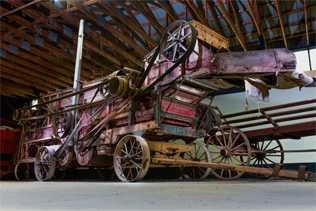



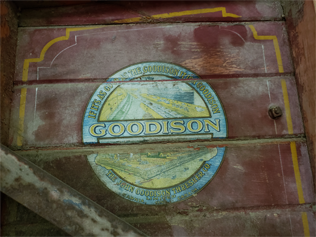
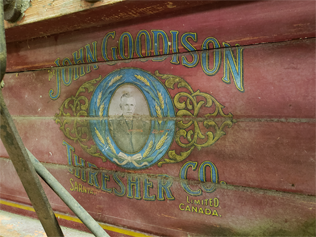

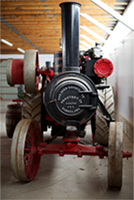
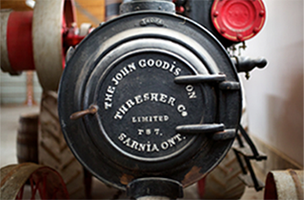
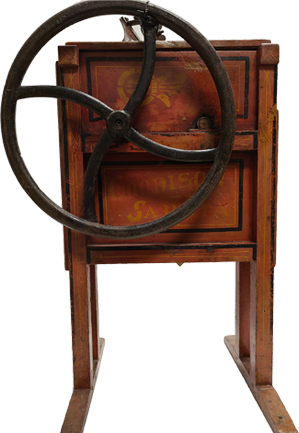

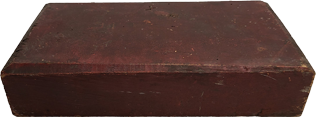

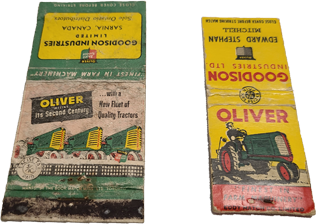
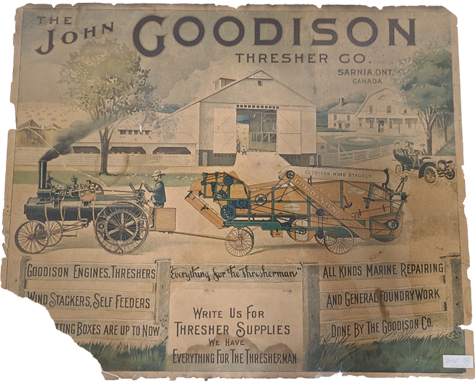
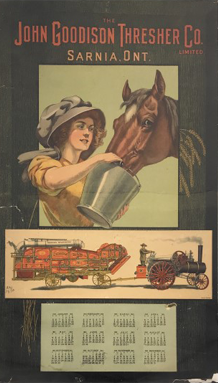
 Subscribe to this page
Subscribe to this page